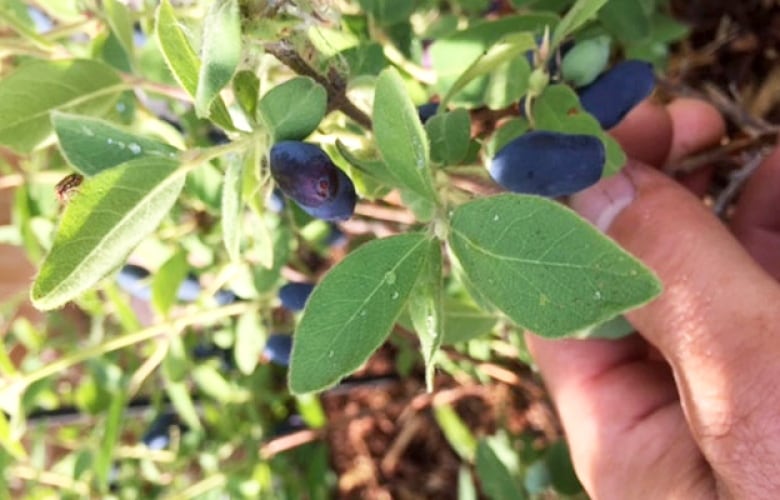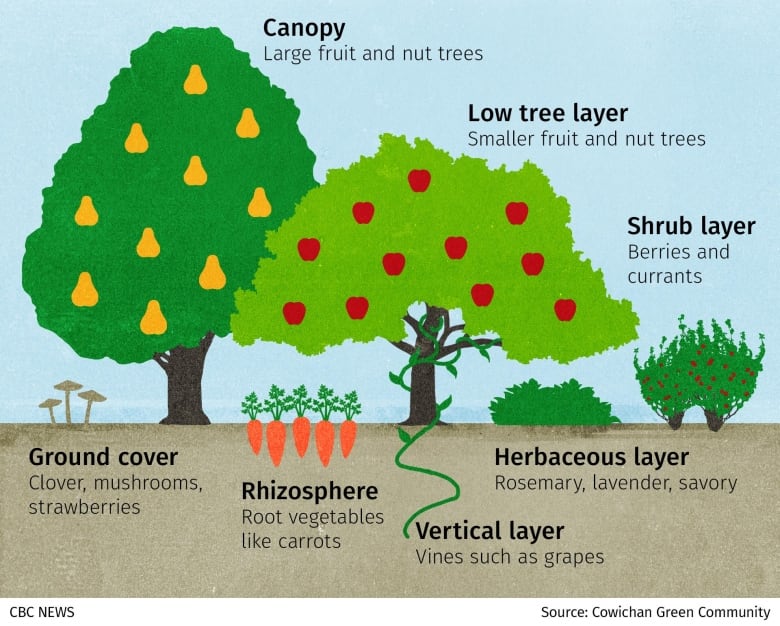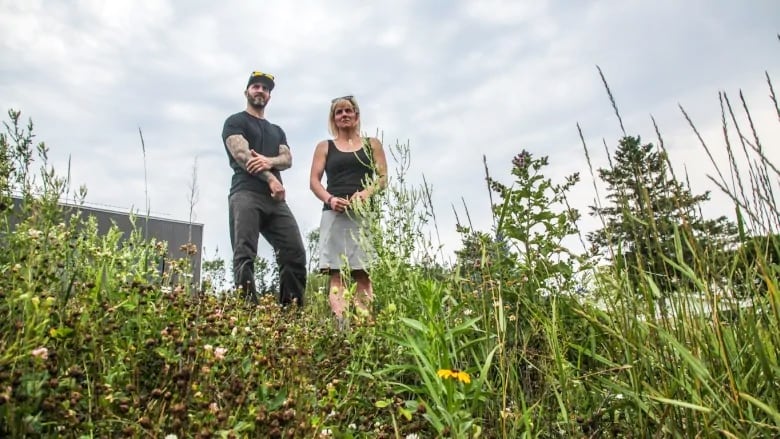Why cities are planting more 'food forests'
Also: The 7 layers of a food forest

Hello, Earthlings!This is our weekly newsletter on all things environmental, where we highlight trends and solutions that are moving us to a more sustainable world.(Sign up hereto get it in your inbox everyThursday.)
This week:
- Why cities are planting more 'food forests'
- The 7 layers of a food forest
- This Quebec couple is fighting for the right to grow a wild garden
Why cities are planting 'food forests'

Many of us see forests as places to walk, hike and enjoy nature. But more and more cities are planting "food forests" not just for strolling through, but for growing fruits and veggies.
At the Cowichan Green Community Food Forest in Duncan, B.C., visitors can amble along green microclover pathways in the shade of big-leaf maple trees to pick herbs such as rosemary and savory, vegetables like asparagus, as well as fruits, including salmonberries, grapes, plums, kiwis and figs for free.
"It's quite the jungle right now," said Janice MacKirdy, who runs the garden for the non-profit Cowichan Green Community Society, an environmental group focused on food security.
The roughly one-acre plot attracts families, who fill their baskets during berry season, and is a refuge and quiet thoroughfare for workers in the city centre. The community group also uses the harvest in its Meals on Wheels program for seniors and sells some at its "reFRESH Store," which rescues surplus and potentially wasted perishable food.
Similar edible landscapes are popping up across the country, from Hay River, N.W.T., to Sudbury, Ont.
Red Deer, Alta., has no fewer than eight community orchards and food forests, planted since 2011, where the public can harvest nuts such as hazelnuts and walnuts and fruit such as haskap berries, cherries, apples and plums.
"This is an amazing activity to get people interacting with nature," said Trevor Poth, parks superintendent for the City of Red Deer.
Both Poth and MacKirdy say urban food forests tend to be more appealing to people who might not normally go hiking or use community gardens, which require more work and personal commitment.
While Red Deer's primary goal is to create a sustainable source of local food, these forests have other benefits, too, such as attracting and supporting birds and pollinators.
The city tries to plant them in partnership with schools or community groups to maximize opportunities to educate the public about where their food comes from and what can be grown locally.
"You teach kids what berries they can eat off what tree," Poth said. "Those kids go home and they tell their parents, and then the parents plant cherry trees in their backyard and they plant haskap and they plant apple trees. So we're really trying to be the driver of change."
He said that while many cities quietly put edible plants along roadways, Red Deer is "quite pushy, in fact, about sharing our knowledge of what we can grow." It provides detailed maps showing exact locations and varieties of edible plants.
Poth said access to this fresh, local food has had a positive impact on people's physical and mental health during the pandemic, which has forced many to look for outdoor activities close to home.
"People are happy or they feel more self-sustaining, and it's been an excellent thing this year. It's been one of the great positives, I think, that's come out of coronavirus."
Emily Chung
Reader feedback
Responding to Emily Chung's story last week on Plastic Free July, Diana Dunlop captured the dilemma of trying to avoid excess packaging during the pandemic.
"I haven't used any plastic bags for packing groceries in these past few months. I just put my purchased groceries back in the cart and pack them when I get to the car. A lot of produce does not need to be bagged, e.g. bananas, potatoes, yams, lemons, etc. However, some organic produce comes bagged, and not sure how to get around that.
"[I] have had to resort to new plastic bags at the bulk food stores, but have those washed and ready to be reused as soon as it is allowable. I have not purchased any bags for at least six years, and reuse produce bags or ones I made myself from curtain netting.
"Horrified at the amount of recyclable material just being chucked at a coffee shop the other day, so I brought mine home so I could recycle and made a commitment to myself not to go there again.
"Am not good with dish soap and laundry soap containers will have to revisit the fill store again, just found them very expensive. But your [newsletter] made me think that I could do more."
Write us atwhatonearth@cbc.ca.
Old issues of What on Earth? are right here.
There's also a radio show! Make sure to listen to What on Earth every Sunday at 10:30 a.m., 11 a.m. in Newfoundland. You can also subscribe to What on Earth on Apple Podcasts, Google Play or wherever you get your podcasts. You can also listen anytime on CBC Listen.
The Big Picture: The 7 layers of a food forest
In order to maximize the amount of food that can be grown in a certain area, food forests are often designed to mimic a natural forest, with similar "layers" of plants that serve different roles in the ecosystem.

Hot and bothered: Provocative ideas from around the web
-
The brand Tupperware is synonymous with reusable containers for food storage. The U.S. company has announced a new initiative called No Time to Waste, in which it is committing to greater sustainability through a number of measures, including creating new materials using mixed plastic waste and reducing its energy and water usage.
-
After tense negotiations including some theatrical fits of anger from leaders like France's Emmanuel Macron the countries of the EU have agreed on a financial recovery plan for the pandemic. And it includes the largest green stimulus plan in history, worth more than 500 billion euros (or almost $750 billion Cdn).
- This week, Swedish climate crusader Greta Thunberg won the inaugural Gulbenkian Prize for Humanity, which recognizes environmental activism. The award is worth $1.14 million US, and Thunberg has announced that $114,000 of that will go to SOS Amaznia, an organization dedicated to protecting the rainforest, and another $114,000 will go to the Stop Ecocide Foundation, which is working to make environmental destruction an international crime.
These Quebecers are fighting for the right to grow a wild garden

A western Quebec couple is in a battle with their municipality over a specially designed yard containing milkweed, tall grasses and wildflowers.
Last summer, the municipality of La Pche informed Jazmine Maisonneuve and Samuel Cloutier, both 37, that the tall-growing vegetation on the commercial property surrounding a new workshop facility in the village of Masham constituted a "nuisance."
La Pche's bylaw requires that lawns be kept no higher than 15 centimetres. Last month, the municipality sent the couple another warning and told them they faced a $400 fine if they didn't mow it.
"We very deliberately and intentionally did not sow grass. We don't want to mow our lawn. We don't want a lawn, in fact we want a meadow," said Maisionneuve, a landscape designer.
The municipality told the couple that a neighbour complained the yard which is filled with milkweed, thistles, Queen Anne's lace and other flowers that attract pollinators lowered neighbouring property values. Maisonneuve rejects that assertion.
"We feel this is much more beautiful than our neighbours' scorched, mowed, brown lawn right now," she said.
Cloutier, a custom home builder and metal fabricator, said he got a call from a municipal employee who told him the municipality would take the couple to court over the tall plants. He also said the municipality told the couple they'd be able to keep the yard if they hired a biologist to catalogue the different wildflowers growing on the property.
But when they paid a biologist $400 and sent photos and descriptions to the municipality, it rejected the report, Cloutier said, as it didn't include a site plan with the locations of the flowers.
Cloutier said he told the municipality he wouldn't spend any more money on flower reports and welcomes an opportunity to fight it out legally.
"It's pretty surprising that in 2020 we're having this discussion," Cloutier said. "I think any judge in court would use their common sense and say, 'Hey, we're wasting our time here.'"
The dispute comes as the Canadian Wildlife Federation (CWF) has a campaign urging utility providers and municipalities not to spray pesticides and to permit public lands, power corridors and rights-of-way to grow over with pollinator-friendly flowers and vegetation.
CWF researcher Carolyn Callaghan said the campaign is also targeting the roughly 6.2 million private residential lawns in Canada.
"Many of us have a long-standing love affair with [a] cut, mown lawn. We think it's neat and tidy and beautiful," said Callaghan. "Unfortunately, it's a desert it does not support many species, and it certainly doesn't support pollinators because there are no flowers."
In an email to CBC News, La Pche Mayor Guillaume Lamoureux said the bylaw was "obsolete and unenforceable." He said he wasn't aware of a case where a property owner had been fined under the bylaw, and he would like to see it removed in a future review.
Lamoureux also said he couldn't be sure if the municipality would make good on its threat to take Cloutier and Maisonneuve to court.
Stu Mills
Stay in touch!
Are there issues you'd like us to cover? Questions you want answered? Do you just want to share a kind word? We'd love to hear from you. Email us atwhatonearth@cbc.ca.
Sign up hereto getWhat on Earth?in yourinbox every Thursday.
Editor: Andre Mayer | Logo design: Skdt McNalty













_(720p).jpg)


 OFFICIAL HD MUSIC VIDEO.jpg)
.jpg)



























































































